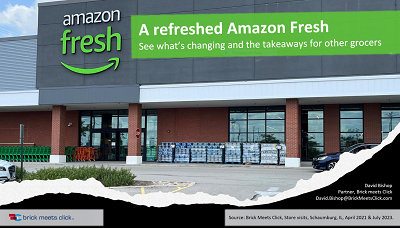Five ways automation will impact grocery retail: The race is on
Complete the form below to instantly download this month's dashboard.

There is much debate about how grocery retailing will evolveover the next 5-10 years – and how much shopper behavior will actually changeas a result of online grocery – but it’s safe to say that leveraging automationwill be one of the ways brick and mortar supermarkets evolve their models to remainviable and profitable. Machines of all shapes and sizes will do at least someof the repetitive work previously executed by people in grocery.
Some of this automation will be relatively simple, like MiniChoice Market’s vending machines for fresh and packaged products; other applicationswill use artificial intelligence/machine learning to maintain and interpretstore conditions, like Marty the robot and xNorAI’s shelf monitoring systems; stillother applications like robotic picking systems will impact more than the taskthey were originally designed for (online order pick rate efficiencies, in thiscase).
Automation's impact
Here are five forecasts about automation’s impact on theprocess of buying and selling food/groceries that can help all of us –retailers, product suppliers, and tech providers – begin to imagine and ultimatelycreate the future.
#1
Leveraging automation will be the primary way inwhich supermarkets remain competitive. They’ll do this by increasingproductivity in three areas of the business.
- Labor – Reducing the number of hours worked toproduce the same volume of sales.
- Inventory - Giving the retailer the tools toreplenish stores with individual items versus case quantities.
- Space - Enabling dynamic adjustments of displayspace that align more closely with sales patterns within the week and even byday.
#2
Automation will attract a more educated and/orengaged and productive workforce to food retailing.
- Increased automation will change the perceptionof the supermarket, making it into a “more desirable” place to work.
- Grocery retailers have already begun to raisesalaries to attract and retain higher quality employees. Soon there will be asimilar increase in their efforts to make their companies “a better place towork” through such actions as
- Shifting from part-time to full-time employment
- Increasing professional and skill-focusedon-the-job training
#3
Automated order selection systems will replace/reduce "self-service" retailing as they improve the efficiency of order fulfillment.
- Auto fulfillment systems not only eliminate theneed for humans to fulfill orders from the aisles, they eliminate the need forin-store shoppers to go up and down the aisles in search of specificshelf-stable items.
- Shoppers place an order for the center storeitems in one of two ways – in-store or ahead of time via the mobile app. Either way, their order is ready for pick-upat the store and they still have ability to shop the store’s perimeterdepartments themselves.
- Waiting in the checkout line is one of thegreatest frustrations of in-store grocery shopping, and if the items in thepick-up order are already assembled and totaled, then check out is much faster.
#4
Longer term, a big impact of automation will beto improve the grocery shopping experience by allowing the customer to enjoytheir own personalized version of the store with curated items that fit theirneeds and priorities.
- Two technologies – augmented reality and virtualreality – are available today and getting better every year. The evolution ofthese “synthetic” realities opens the way to deliver what looks and feels likea traditional in-store shopping experience any place and any time.
- This enhanced online shopping experience, combinedwith the ability to customize the product assortment to individual/householdpreferences and optimize search/navigation capabilities, will change the faceof food retailing.
#5
In the true spirit of disruption, thegame-changing power of automation will be fully realized only when technicalbreakthroughs drive significantly lower retail costs.
- Repurposing current technology is easy enough,so many retailers will choose that path and forego the opportunity to createsustainable, competitive advantage.
- Significant retail cost reduction will justifythe greater investment in automation, but only some competitors will invest inthe new way of doing business, others won’t be able to step up.
The race is on
For two compelling reasons, now is the time to startevaluating and testing the different types of automation that will help agrocer strengthen its competitive position and value proposition.
Competitive pressure: Some grocersand food retailers have already moved past testing to rolling out differenttypes of automation, and it looks like there’s plenty more activity like thisand automation development in the pipeline.
Time pressure: Even some of thebasic forms of automation will take time to integrate into the business model,so beginning today just makes sense.
Returning to the predictions above – this isn’tabout automation for automation’s sake, it’s about remaining competitive,increasing productivity, valuing your employees, and giving your customers the productsand shopping experiences they want.

Editor's note: Grocery Expiration Date: Automate or Die - a panel discussion featuring John Lert of Alertinnovation, Scott DeGraeve of Locai, Will Treasure of Javelin Group and Bill Bishop from Brick Meets Click was recorded on the Technology Revolution The Future of Now radio show on Wed. Sept 18, 2019. Listen to the episode now .
Related Posts
> Automation's impending impact on grocery: Where to focus (blog)
> New store-of-the-future model replaces part of an existing grocery's center aisle space
> CommonSense Robotics' unique approach to automated fulfillment
> The self-checkout investment choice has major implications for grocery retailer success
Brick Meets Click is a strategic advisory firm with extensive experience, expertise, and perspective on changes challenging the retail grocery industry. We work with organizations to create and evaluate the right path forward to growth in today’s integrated physical/digital ecosystem. Learn more about our services .










